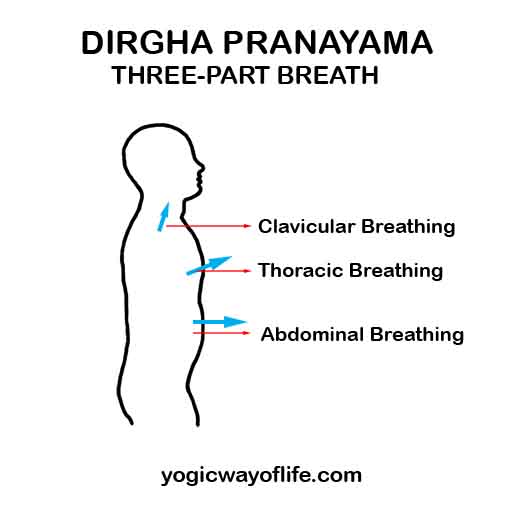Dirgha Pranayama or the three-part breathing exercise is also known as yogic breathing or the full breath. In Sanskrit, Dirgha means long. In Dirgha pranayama, complete breathing is done with expansion of the abdomen, chest and the neck region. It is described in three steps, but the actual breathing process is done as a single continuous process.. Dirgha Pranayama or yogic breathing is about finding your natural breath. To understand the yogic breath, we have to observe the spontaneous breathing in an infant. As babies we breathe naturally, without any distortions. If you look at a baby during sleep, the breath is slow and rhythmic. The belly goes up and down, expanding and contracting with ease. This is a fully relaxed breath. We breathe from our abdomen, when relaxed. When we are tense, the breath tends to be short and comes from the chest and the neck region.
Purpose of Dirgha Pranayama
Purpose of Dirgha Pranayama is to correct our unnatural breathing habits. Tension and stress disturbs our natural breath. During stress, we tend to breathe more from the chest and neck. Over a period of time this may become a habit, and we forget the natural relaxed way of breathing. Bad work postures also distort our natural breathing. Observe yourself when you are working on the computer and see how different postures affect your breathing. By observation and awareness of our movements and postures, we can correct these postures and develop natural, healthy breathing habits. It is also observed that women tend to breathe from the chest and neck during pregnancy. This is natural, as the diaphragm will make adjustments to its movements to accommodate the additional weight of the fetus. What happens is that after pregnancy too, many women tend to breathe from the chest and neck (clavicular breathing) due to this acquired habit. Dirgha Pranayama helps to correct the unnatural breathing habits.
How to do Dirgha Pranayama (the Three-Part Breath)?
Yogic breathing should come naturally. But since many of us develop irregular breathing habits over the years, it is good to consciously practice the three-part breath, in order to undo some of those wrong habits.
- Sit in any comfortable posture like Sukhasana, Vajrasana, Swastikasana or Padmasana. You may also try this sitting on a chair, with palms resting on thighs.
- Take few normal breaths and relax completely. Move your awareness to every part of your body, while relaxing them one by one.
- Now, observe your breath. Just relax and observe, without forcing the breath. Then, start the yogic breathing practice as described below.
- Start with a slow deep breath, filling the belly first. Observe the expansion of the abdomen. Continue inhaling.
- At some stage of abdominal expansion, the chest expansion (or thoracic breathing) takes over and becomes prominent.
- Further, at some stage of chest expansion, the neck expansion (clavicular breathing) takes over and become prominent.
- One stage merges into the other. You will observe that during all stages, every region expands to some extend or the other; yet only one region is prominently expanding in each stage. This is a natural process. Do not strain to do this. Any strain will disturb the natural breathing process. Just be aware of the natural respiratory mechanism.
- Once the breath is full, start the process of exhalation. When you exhale, observe the reversal of this process taking place. Expel the air from the neck region first, then from the chest and finally from the abdomen. Please note that when we say expelling from the abdomen, the air is actually expelled from the lungs only. The abdomen contracts only because of the upper movement of the diaphragm.
- This is one round of Dirgha Pranayama. Do a few rounds of this slow and natural breathing. Observe every movement related to your breathing process. Practicing this way, we can get back our natural breath, something we relished as a baby.
- You can try practicing this even during other light activities during the day. This may even be practised in the lying down position or Shavasana.
Benefits of Dirgha Pranayama
- Dirgha Pranayama or yogic breathing helps us to find our natural breath. Natural breathing de-stresses our body. It removes stress in the muscles and organs.
- It slows down the breathing rate and calms the mind. There is a close connection between mind and breath. When the mind is calm, the breath is slow and natural. When stressed, the breath becomes short and irregular.
- Dirgha Panayama slows down your thoughts and prepares the mind for meditation.
- The full inhalation nourishes the body with ample supply of oxygen. Also the full exhalation throws out stale air accumulated in the lower parts of the lungs. This detoxifies your body.
- This natural process of breathing will correct all our unnatural breathing habits, developed over years.
- Dirgha Pranayama reduces the strain on your heart as the body gets extra supply of oxygen with each breath.
- This is a good practice to develop awareness, which will reflect in our day to day activities.

